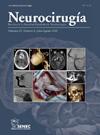Relationship between optic nerve length and interoptic angle in the prediction of optic chiasm location
IF 0.8
4区 医学
Q4 NEUROSCIENCES
引用次数: 0
Abstract
Introduction and objectives
The sellar region is an area in the base of the skull that is among the most common sites for tumors of the central nervous system. Surgical interventions are currently performed via different routes. While the optic chiasm occupies its expected position in 70% of the population, it can deviate from this position. In such cases, surgery involving this region becomes more difficult as the known surgical routes are narrowed. Advance awareness of these variations can help surgeons to identify the optimal route for safe surgical intervention in the sellar region. By performing simple measurements of both the lengths of the optic nerves and the angle between them, a surgeon can predict the location of the chiasm.
Materials and methods
Twenty specimens collected from autopsies performed at Bursa Forensic Medicine İnstitute were examined to determine the optic chiasm types and the relationships between the surrounding subchiasmal structures.
Results
Among the 20 specimens, we found two prefixed (10%), 10 normo-fixed (50%), and eight postfixed chiasms (40%). The mean interoptic angle was 81.03 (±17.41)⁰. Prefixed chiasms had angles in the range 115.36°–124.76 ° (mean 120.06 [±6.65]⁰), normo-fixed chiasm angles were between 83.11° and 97.53 ° (mean 86.07 [±6.73]⁰), and postfixed chiasms ranged between 53.01 ° and 78.71 ° (mean 69.20 [±9.13]⁰). The length of the right optic nerve ranged between 6.95 and 13.83 mm (mean 10.25 [±1.81] mm), and the length of the left between 7.25 and 12.51 mm (mean 10.40 [±1.47] mm). Obtuse angles indicated that the chiasm was prefixed, and acute angles were indicative of a postfixed chiasm. There was a strong negative correlation between optic nerve lengths and the interoptic angle; thus, as the length of the nerves increases, the interoptic angle becomes more acute.
Conclusions
We have proposed a simple measurement of the optic nerve lengths and the angle between them to predict the relative location of the OC, which can be done easily on MRI.
视神经长度与视间角在视交叉位置预测中的关系
鞍区是颅底的一个区域,是中枢神经系统肿瘤最常见的部位之一。手术干预目前通过不同的途径进行。虽然视交叉在70%的人群中占据了预期的位置,但它可能会偏离这个位置。在这种情况下,由于已知的手术路线变窄,涉及该区域的手术变得更加困难。提前意识到这些变化可以帮助外科医生确定鞍区安全手术干预的最佳途径。通过对视神经的长度和视神经之间的角度进行简单的测量,外科医生可以预测交叉的位置。材料和方法从法尔萨法医İnstitute收集的20例尸检标本进行了检查,以确定视交叉类型和周围交叉下结构之间的关系。结果20例标本中,有2例为前交叉(10%),10例为正交叉(50%),8例为后交叉(40%)。平均视间角为81.03(±17.41)⁰。前置交叉的角度在115.36°-124.76 °(平均120.06[±6.65]⁰)范围内,正常固定交叉的角度在83.11°和97.53 °之间(平均86.07[±6.73]⁰),后固定交叉的范围在53.01 °和78.71 °之间(平均69.20[±9.13]⁰)。右侧视神经长度为6.95 ~ 13.83 mm(平均10.25[±1.81]mm),左侧视神经长度为7.25 ~ 12.51 mm(平均10.40[±1.47]mm)。钝角表明交叉是前置的,锐角表明交叉是后固定的。视神经长度与视间角呈显著负相关;因此,随着神经长度的增加,视间角变得更尖锐。结论我们提出了一种简单的测量视神经长度和视神经之间的角度来预测OC的相对位置,这在MRI上很容易做到。
本文章由计算机程序翻译,如有差异,请以英文原文为准。
求助全文
约1分钟内获得全文
求助全文
来源期刊

Neurocirugia
医学-神经科学
CiteScore
1.30
自引率
0.00%
发文量
67
审稿时长
60 days
期刊介绍:
Neurocirugía is the official Journal of the Spanish Society of Neurosurgery (SENEC). It is published every 2 months (6 issues per year). Neurocirugía will consider for publication, original clinical and experimental scientific works associated with neurosurgery and other related neurological sciences.
All manuscripts are submitted for review by experts in the field (peer review) and are carried out anonymously (double blind). The Journal accepts works written in Spanish or English.
 求助内容:
求助内容: 应助结果提醒方式:
应助结果提醒方式:


